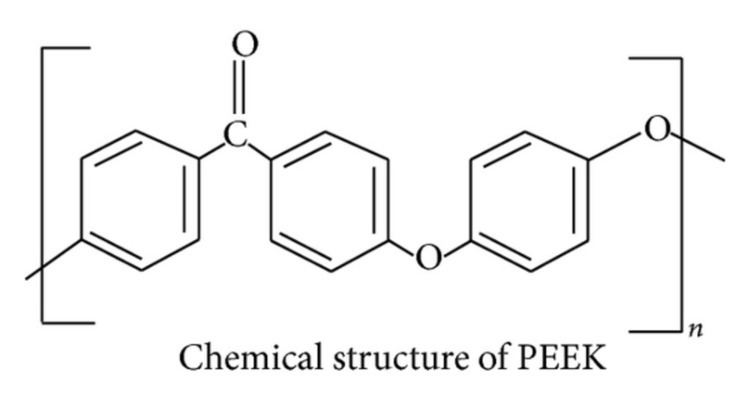Density 1.32 g/cm³ | ||
 | ||
Polyether ether ketone (PEEK) is a colourless organic thermoplastic polymer in the polyaryletherketone (PAEK) family, used in engineering applications.
Contents
- Synthesis
- Properties
- Applications
- Processing options
- Shape memory PEEK in biomechanical applications
- References

Synthesis

PEEK polymers are obtained by step-growth polymerization by the dialkylation of bisphenolate salts. Typical is the reaction of 4,4'-difluorobenzophenone with the disodium salt of hydroquinone, which is generated in situ by deprotonation with sodium carbonate. The reaction is conducted around 300 °C in polar aprotic solvents - such as diphenyl sulphone.
Properties

PEEK is a semicrystalline thermoplastic with excellent mechanical and chemical resistance properties that are retained to high temperatures. The processing conditions used to mold PEEK can influence the crystallinity, and hence the mechanical properties. The Young's modulus is 3.6 GPa and its tensile strength 90 to 100 MPa. PEEK has a glass transition temperature of around 143 °C (289 °F) and melts around 343 °C (662 °F). Some grades have a useful operating temperature of up to 250 °C (482 °F) . The thermal conductivity increases nearly linearly versus temperature between room temperature and solidus temperature. It is highly resistant to thermal degradation as well as attack by both organic and aqueous environments. It is attacked by halogens and strong Bronsted and Lewis acids as well as some halogenated compounds and aliphatic hydrocarbons at high temperatures. It is soluble in concentrated sulfuric acid at room temperature, although dissolution can take a very long time unless the polymer is in a high surface area to volume form such as a fine powder or thin film. It has high resistance to biodegradation.
Applications
Because of its robustness, PEEK is used to fabricate items used in demanding applications, including bearings, piston parts, pumps, HPLC columns, compressor plate valves, and cable insulation. It is one of the few plastics compatible with ultra-high vacuum applications. PEEK is considered an advanced biomaterial used in medical implants, e.g., use with a high-resolution magnetic resonance imaging (MRI), for creating a partial replacement skull in neurosurgical applications. It is finding increased use in spinal fusion devices and reinforcing rods. It is extensively used in the aerospace, automotive, and chemical process industries.
Processing options
PEEK melts at a relatively high temperature (343 °C / 649.4 °F) compared to most other thermoplastics. In the range of its melting temperature it can be processed using injection moulding or extrusion methods. A San Francisco company demonstrated for the first time the technical possibility of processing granular PEEK into filament form and 3D printing parts from the filament material using fused deposition modeling – FDM (or fused filament fabrication – FFF) technology. In January 2016 the German startup Indmatec GmbH, now Apium Additive Technologies GmbH, located in Karlsruhe, presented a PEEK filament for producing medical devices up to class IIa. With this new filament, it is possible to use the FFF method for different medical applications like dentures.
In its solid state PEEK is readily machinable, for example, by (CNC) milling machines and is commonly used to produce high-quality plastic parts that are thermostable and both electrically and thermally insulating. PEEK is considered a high-performance polymer, that is to say, its high price restricts its use to the most demanding applications only.
Shape-memory PEEK in biomechanical applications
PEEK is not traditionally a shape-memory polymer; however, recent advances in processing have allowed shape-memory behavior in PEEK with mechanical activation. This technology has expanded to applications in orthopedic surgery.
